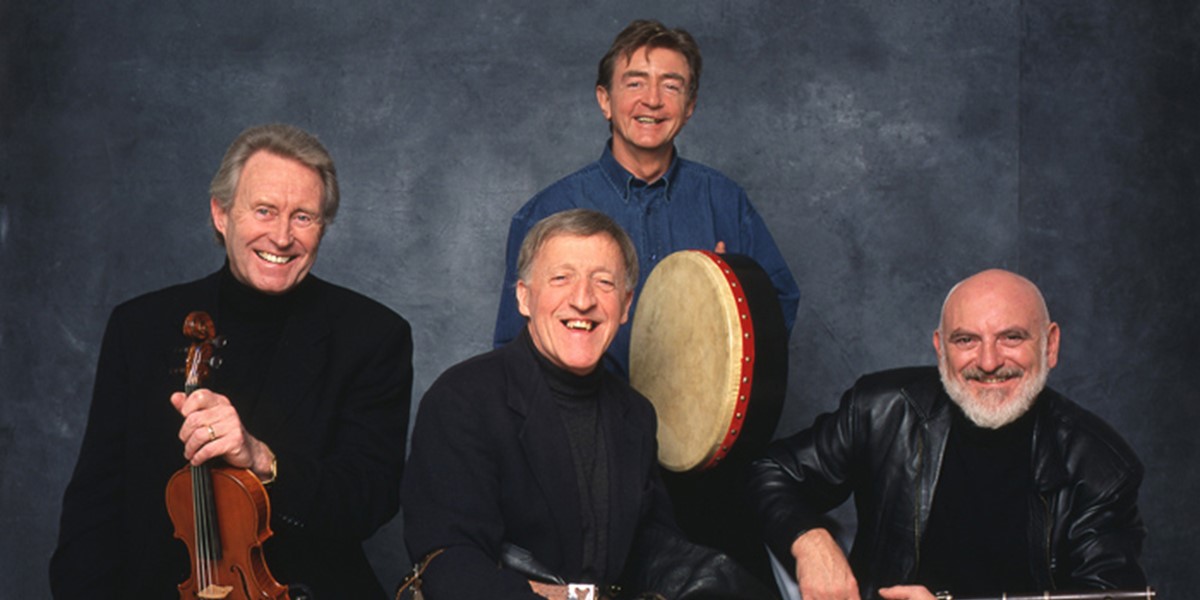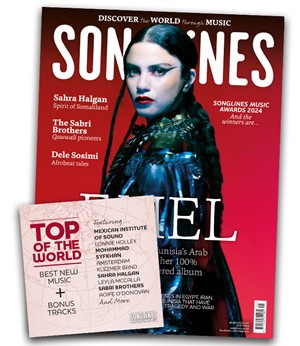Tuesday, February 20, 2018
The Chieftains: A Beginner’s Guide
Nigel Williamson looks back at the enduring global popularity of the Irish musical ambassadors

(photo Barry McCall)
Paddy Moloney once joked that there are only two kinds of musician in the world – the Irish and those who wish that they were. Although it was said with a mischievous twinkle, the list of those who have worked with The Chieftains suggests he may have had a point.
The Rolling Stones, Roger Daltrey, Ry Cooder, Elvis Costello and Sting have all queued to record with Ireland’s best-loved traditional group. So, too, have Marianne Faithfull, Tom Jones, Joni Mitchell, Willie Nelson, Natalie Merchant, Art Garfunkel, Ziggy Marley, Emmylou Harris, Béla Fleck, Pavarotti, Earl Scruggs and a host of others, not to mention a bunch of younger artists not even born when The Chieftains started playing together, including Bon Iver, Paolo Nutini and the Carolina Chocolate Drops. Rock stars, pop singers, country artists, reggae musicians and operatic titans – who in their right mind would turn down the chance to work with the Chieftains? Even NASA astronaut Cady Coleman recorded an extra-terrestrial collaboration with them, playing the flute aboard the International Space Station as it orbited the earth.
To Moloney, who founded the group in Dublin in 1962 and has led it ever since, all of the world’s musicians are honorary Irishmen. Ry Cooder tells a story of working with the uilleann piper in Havana: “Every Cuban song we played him, he said it reminded him of an Irish tune. I swear Paddy thinks all the music in the world originally came from Ireland.” True to form, when The Chieftains toured with a group of Mongolian throat singers, Moloney was convinced that he had detected “the rhythms of an Irish jig” in their music.
When the Chieftains formed, playing traditional Irish instrumental music was not a living but a recreation, pursued in pub sessions in return for a few free pints. It was 13 years and four albums into their career before they turned professional – and in the end it took a wager to persuade them. When promoter Jo Lustig booked them to play London’s Royal Albert Hall in 1975, Moloney told him he was mad to hire such a large venue but that if he could sell it out, they would give up their day jobs. There wasn’t an empty seat in the house.
By the end of 1975 The Chieftains had signed to Island Records, recorded the soundtrack to Stanley Kubrick’s film Barry Lyndon and were voted group of the year in the annual Melody Maker poll, improbably beating The Rolling Stones and Led Zeppelin.
Turning professional brought a settled line-up that included founder members Moloney, fiddler Martin Fay and tin whistler Sean Potts, augmented by harpist Derek Bell, who joined in 1975, bodhrán player Kevin Conneff who replaced Peadar Mercier a year later, and finally flautist Matt Molloy, who took over from Michael Tubridy in 1979. The line-up remained unchanged until Bell’s death in 2002 and has continued to this day without him.
The group’s first five albums were entirely instrumental but 1976’s The Chieftains 6: Bonaparte’s Retreat began the practice of using guest vocalists, in this case Dolores Keane of traditional Irish band De Dannan, while Conneff stepped up to the plate as the group’s in-house singer.
By the 80s The Chieftains had embarked on a series of albums that sought to fuse traditional Irish music with a range of other genres. Year of the French (1983) teamed them with a symphony orchestra. Celtic Wedding (1987) was an exploration of traditional Breton music. The following year came the hit album Irish Heartbeat with Van Morrison.
High-profile gigs playing on the Great Wall of China, performing at the US Capitol Building and entertaining the Pope led to the Irish government in 1989 making them honorific ‘musical ambassadors,’ a title that came with the issue of leather diplomatic cases with their status proudly embossed in gold.
The 1990s brought a Christmas album featuring Jackson Browne, Rickie Lee Jones and Elvis Costello, a Nashville-recorded country album, a live record with Roger Daltrey and Nanci Griffith and a Celtic rock album, which featured The Rolling Stones. Another album explored the folk music of Galicia and 1999’s Tears of Stone featured a different female vocalist on every track.
But other members of the group were growing increasingly concerned that The Chieftains were straying too far from their roots. “It’s all been great, but I’ve told Paddy we really need to make a proper traditional Irish album again,” Molloy told this writer in 1999. He got his way with 2000’s Water from the Well, but it was soon followed by two further Nashville-recorded albums featuring a plethora of top American country stars.
In recent years, the flood of recordings has slowed to a trickle; but the group marked its 50th anniversary with 2012’s Voice of Ages, which teamed the veterans with a cleverly chosen raft of young indie acts, and they remain one of the world’s great live attractions.
“Somebody once asked my wife ‘is he ever going to retire?’ and she said, ‘He’s in rehearsal for it,’” says Moloney. “That was ten years ago”
BEST ALBUMS
The Chieftains 4
(Claddagh, 1973)
The finest of their early albums includes a recording of Seán Ó Riada’s composition ‘Mná na hÉireann (Women of Ireland)’, which brought them to the attention of Stanley Kubrick, who used it in his 1975 film Barry Lyndon.
The Long Black Veil
(BMG, 1995)
On this album they roared down the ‘Rocky Road to Dublin’ with The Rolling Stones, invited Mick Jagger to sing on the title-track, gave cameo roles to Sting, Sinéad O’Connor and Van Morrison and began a productive partnership with Ry Cooder.
Santiago
(BMG, 1996)
Moloney called Galicia “the world’s most undiscovered Celtic country.” In addition to examining its heritage with Galician musicians Carlos Núñez and Kepa Junkera, he also rounded up Los Lobos, Ry Cooder and Linda Ronstadt to explore the influence of Galician migrants on Latin American music.
San Patricio
(Decca, 2010)
The group’s third album to feature Cooder told the story of a battalion of Irish volunteers who deserted the US army in 1846 to fight for the other side in the Mexican-American war. Lila Downs and a vast cast of Mexican musicians help out, and Liam Neeson adds the narrative. Reviewed in #67.
Voice of Ages
(Concord, 2012)
Released to commemorate the group’s 50th anniversary, this clearly demonstrates their incredible pulling power, as it features an array of special guests from Paolo Nutini, Imelda May and Bon Iver to the Punch Brothers. A Top of the World review in #84.
IF YOU LIKE THE CHIEFTAINS THEN TRY…
The Gloaming
(Real World, 2014)
This is traditional Irish acoustic music at its best with a fresh perspective from a Celtic ‘supergroup’ featuring fiddle player Martin Hayes, guitarist Dennis Cahill and sean nós and ex-Afro Celt Sound System singer Iarla Ó Lionáird. A Top of the World in #98.








